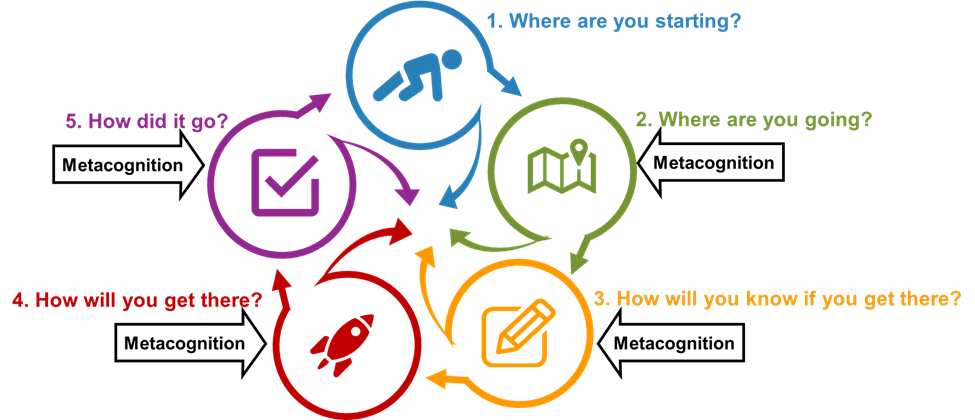
Unit A – Teaching & Learning Theories
A4. Metacognition
Metacognition
In its most basic definition, metacognition is thinking about thinking. “Metacognition refers to an individual’s awareness and critical analysis of their own thought processes and cognitive ability” (Derek Bok Center for Teaching and Learning, 2018)
For students to have a transformative learning experience, they must think about their thinking. For example, in an ‘Aha’ moment, the student becomes aware of what their previous thoughts/believes as well as what their new thoughts/believes are. This typically does not occur unless the student is critically or creatively reflecting (Bloom’s cognitive taxonomy HOTS – discussed in Chapter A6).
“When students employ metacognition, they become consciously aware of themselves as problem-solvers, which enables them to actively seek solutions to any problems they may encounter rather than relying on others to tell them what to do or answer their questions” (McGuire & McGuire, 2015, p. 16).
Your Role In Teaching Metacognition
Many researchers (such as Chick, 2013; Hattie, 2015; Hofer & Sinatra, 2010; McGuire & McGuire, 2015; Saaris, 2017; D. Wilson & Conyers, 2014) emphasize the importance of teaching students about metacognition. Weimer (2012)states “[I]t is terribly important that in explicit and concerted ways we make students aware of themselves as learners. We must regularly ask, not only ‘What are you learning?’ but ‘How are you learning?’ We must confront them with the effectiveness (more often ineffectiveness) of their approaches. We must offer alternatives and then challenge students to test the efficacy of those approaches.”
Model metacognition by “being explicit about ‘how you start, how you decide what to do first and then next, how you check your work, how you know when you are done” (From Tanner, 2012, as quoted by Chick, 2013). Students “often laugh when their teachers make ‘mistakes,’ and they learn when their teachers stop, recognize the miscue, and step through the process of correcting.” (Wilson & Conyers, 2014).
By teaching our students about metacognition and approaches to study, we provide them with the skills, knowledge, and abilities to practice higher-order thinking. “It makes sense that individuals who are strategic in their learning are more successful than those who do not reflect on the learning process” (Saaris, 2017). Learning outcomes on metacognition can lead to transformative learning.
According to McGuire & McGuire (2015, p. 44), instructors can help students learn to think about their thinking by teaching them about Bloom’s taxonomies and metacognitive strategies.
McGuire & McGuire’s Strategies
McGuire & McGuire (2015, pp.171-173) provide a list of 33 strategies for teaching students about metacognition and study strategies. They also provide a list of strategies for students (pp. 167-168) that you can provide to students. Their book explains each of these strategies in detail.
Many of their teaching strategies have been incorporated into the IDI & Metacognition steps below.
IDI & Metacognition

The following describe actions you can take to use concepts from metacognition in the IDI model:
Step 2. Where are You Going?
2.1 Write Learning Outcomes & Objectives
- “Explicitly teach students about this essential learning skill by defining the term metacognition” (Wilson & Conyers, 2014).
- “Create a course syllabus that makes your expectations, course structure, requirements for success, and student responsibilities crystal clear” (McGuire & McGuire, 2015, p.171).
Step 3. How Will You Know If You Get There?
3.1 Develop Assessments & Rubrics
- “Whenever possible, let students choose what they want to read and topics they want to learn more about. When they are genuinely interested and motivated to learn about a topic of study, students are apt to sustain interest in thinking about a project over the long haul” (Wilson & Conyers, 2014).
- “Allow students to choose paper, project, or discussion topics” (McGuire & McGuire, 2015, p.172).
- “Clearly articulate assignment expectations to students and provide rubrics and exemplars if possible” (McGuire & McGuire, 2015, p.172).
- Use peer assessment – “Students can help get in the habit of assessing different learning strategies by judging work” (Saaris, 2017).
- “Interweave assessment and teaching by testing early (within the first two weeks) and often. Doing so will encourage more students to keep pace with the course” (McGuire & McGuire, 2015, p.172).
- “Provide early opportunities for success so that students can build confidence in their ability to excel in the course” (McGuire & McGuire, 2015, p.172).
- “Help students achieve gradual, persistent growth by beginning with manageable homework and tests and incrementally increasing the level of difficulty” (McGuire & McGuire, 2015, p.172).
- Add formative assessments to support students’ understanding of their own knowledge
- Use preassessments: “Encouraging Students to Examine Their Current Thinking: ‘What do I already know about this topic that could guide my learning?’” (From Tanner, 2012, as quoted by Chick, 2013)
- Use Reflective Journals: “Providing a Forum in Which Students Monitor Their Own Thinking: ‘What about my exam preparation worked well that I should remember to do next time? What did not work so well that I should not do next time or that I should change?’” (From Tanner, 2012, as quoted by Chick, 2013)
- On all assessments, “build in a one question for students to ask themselves … ‘How did you figure that out?’” (Saaris, 2017).
- Develop pre and post reading polls to guide students on important points (Saaris, 2017). Many textbooks now include these. Consider making them mandatory. To ease in grading, consider peer assessment of the answers.
- “Give students opportunities to work together in small groups by administering group quizzes, group problem-solving exercises, or group projects” (McGuire & McGuire, 2015, p.172).
- “Assign students real-world tasks to help them develop a sense of belonging to the larger community” (McGuire & McGuire, 2015, p.172).
- Increase writing: “Writing is a particularly useful way to make metacognition visible because it enables students to look back on their previous notes and see how their thinking has changed” (Saaris, 2017).
After the assignment is graded
- “Retrospective Postassessments—Pushing Students to Recognize Conceptual Change: ‘Before this course, I thought evolution was… Now I think that evolution is ….’ or ‘How is my thinking changing (or not changing) over time?’” (From Tanner, 2012, as quoted by Chick, 2013)
- Make revisions part of assignments – “Students benefit tremendously from opportunities to revise their work and reflect on how their thinking has improved” (Saaris, 2017).
Feedback
- Provide specific & targeted feedback: The purpose of feedback is to help them learn. See Chapter C10 on feedback.
Step 4. How Will You Get There?
4.1 Develop & Teach Course
- “Teach students about metacognition, Bloom’s Taxonomy, and the study cycle” including asking students to think about how they have been studying (McGuire & McGuire, 2015, p.172). .
- Present Bloom’s Taxonomy – explain each level of the hierarchy and then apply Bloom’s to an example. “Ask: at what level of Bloom’s have you been operating? At what level do you need to be operating now?” (McGuire & McGuire, 2015, Chapter 4).
- “Integrate short reflection (oral or written) that ask students what they found challenging or what questions arose during an assignment/exam/project” (From Tanner, 2012, as quoted by Chick, 2013)
- “Meet students where they are and teach them basic skills necessary for success. Students may not come fully prepared, but they can still do well if a little time is spent helping them review the basics” (McGuire & McGuire, 2015). Identify a class session after the first exam or quiz to discuss metacognition and study skills (McGuire & McGuire, 2015, p.172).
- Provide students with a list of strategies for studying and links to websites and books on studying (McGuire & McGuire (2015) provide these in their book.)
- “Partner with the campus learning center to provide learning strategies information” (McGuire & McGuire, 2015, p.173).
- “Do a short weekly goal-setting exercise with students” (McGuire & McGuire, 2015, p.172).
- “Provide guidelines for working effectively in groups” (McGuire & McGuire, 2015, p.172).
Emphasize student abilities
- “Help students develop a growth mindset about intelligence by showing “before and after” exam scores of other students who went from Ds or Fs to As and Bs” (McGuire & McGuire, 2015, p.171).
- “Emphasize that students’ actions, not their intelligence, will determine their success” (McGuire & McGuire, 2015, p.171).
- “Establish high expectations and show students how to meet those expectations on the first day of class” (McGuire & McGuire, 2015, p.171).
Provide variety of activities
- “Allow students to play learning games, like Who Wants to Be a Millionaire or Jeopardy!, to review course material” (McGuire & McGuire, 2015, p.172).
- “Introduce ‘switch days’ during which students will be called upon to teach some of the concepts” (McGuire & McGuire, 2015, p.172). Or use an ‘each-one-teach-one’ strategy to have students teach each other. If students know they will be teaching a topic, they will usually study more deeply.
- “Experiment with different ways to deliver learning strategies to students, and have faith that your students can and will improve their learning” (McGuire & McGuire, 2015, p.173).
- Use “group quizzes, group problem-solving exercises, or group projects” (McGuire & McGuire, 2015, p.172).
- “Introduce active learning strategies such as think-pair-share, small group solving and reflection questions” (McGuire & McGuire, 2015, p.172).
- “Connect the course topics and learning activities to your students’ interests” (McGuire & McGuire, 2015, p.172).
- “Look for opportunities to discuss and apply metacognition across core subjects and in a variety of lessons so that students can transfer it for the most benefit” (Wilson & Conyers, 2014).
- “Give students a task to complete at the end of class as an ‘exit ticket.’ This one- or two-sentence summary of the day’s important concepts will help students consolidate their comprehension“ (McGuire & McGuire, 2015, p.172). For example, “The Muddiest Point—Giving Students Practice in Identifying Confusions: ‘What was most confusing to me about the material explored in class today?’” (From Tanner, 2012, as quoted by Chick, 2013)
First Day
- “Engage students in a metacognitive, get-acquainted activity on the first day of class” (McGuire & McGuire, 2015, p.171).
Ongoing
- Model your thought processes (Saaris, 2017; Wilson & Conyers, 2014). “We’ve found that students learn a lot from listening as their teachers use higher-order thinking strategies aloud.
- “Giving Students License to Identify Confusions within the Classroom Culture: ask students what they find confusing, acknowledge the difficulties” (From Tanner, 2012, as quoted by Chick, 2013)
- “Discuss the importance of adequate rest, proper nutrition, and exercise for academic success” (McGuire & McGuire, 2015, p.173).
- “Stay connected to each student so he or she does not feel invisible” (McGuire & McGuire, 2015, p.172).
- “Discuss attribution theory with students so they recognize if they are unrealistically attributing their successes and failures to causes outside of their control” (McGuire & McGuire, 2015, p.171).
- “Give a 45-60-minute learning strategies presentation after students receive the results of their first test or quiz” (McGuire & McGuire, 2015, p.171).
Step 5. How Did It Go?
5.1 Evaluate Course Success
- Use the class outline to note how various activities worked.
References
Chick, N. (2013, February 10). Metacognition. Vanderbilt Center for Teaching. https://cft.vanderbilt.edu/guides-sub-pages/metacognition/.
Derek Bok Center for Teaching and Learning. (2018, November 16). The Science of Learning. Harvard University. https://bokcenter.harvard.edu/science-learning.
Hattie, J. (2015). The applicability of Visible Learning to higher education. Scholarship of Teaching and Learning in Psychology, 1(1), 79–91. https://doi.org/10.1037/stl0000021.
Hofer, B. K., & Sinatra, G. M. (2010). Epistemology, metacognition, and self-regulation: Musings on an emerging field. Metacognition and Learning, 5(1), 113–120. https://doi.org/10.1007/s11409-009-9051-7.
McGuire, S. Y., & McGuire, S. (2015). Teach students how to learn: Strategies you can incorporate into any course to improve student metacognition, study skills, and motivation (First edition). Stylus Publishing, LLC.
Saaris, N. (2017, February 23). Mastering Metacognition: The What, Why, and How. Actively Learn. https://www.activelylearn.com/post/metacognition.
Weimer, M. (2012, November 19). Deep Learning vs. Surface Learning: Getting Students to Understand the Difference. The Teaching Professor. https://www.teachingprofessor.com/topics/for-those-who-teach/deep-learning-vs-surface-learning-getting-students-to-understand-the-difference/.
Wilson, D., & Conyers, M. (2014, October 7). Metacognition: The Gift That Keeps Giving. Edutopia. https://www.edutopia.org/blog/metacognition-gift-that-keeps-giving-donna-wilson-marcus-conyers.
